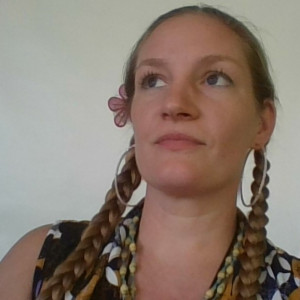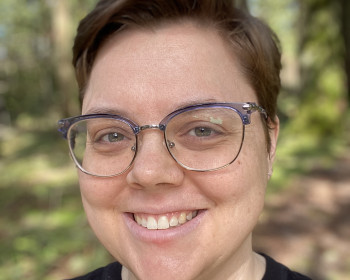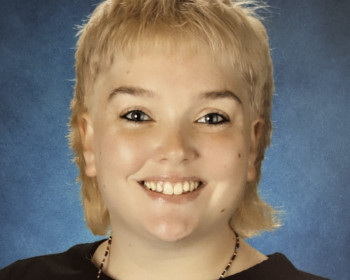Ro Jane Prideaux de Braga ’16
Secondary Art MAT ’16
(she/her)
Additional credentials: I added the field of Japanese to my licensure. And my BA in Foreign Languages is ALSO from L&C!
Current position: Japanese and Art high school teacher at Pahoa High and Intermediate School, Big Island of Hawai’i

Ten years after I completed my Bachelor’s degree at Lewis & Clark I returned for my Master’s (MAT). I was pulled into the field of teaching by a series of experiences I had in the workplace - mainly injustices and inequities I saw in society and in schools that I wanted to help rectify by intervening at the greatest level of influence I felt I could. I researched programs and found that the accelerated program, albeit an enormous financial investment, would be the best fit for me and my goals. I was also very drawn to L&C’s focus on social justice perspectives in preparing teachers, despite the obvious inaccessibility of the program itself to many potential candidates due to financial and other barriers.
How prepared did you feel as a first year art teacher?
Quite prepared! I started teaching Art a year and a half after graduating, having worked in the field of my secondary endorsement (ESOL) first, then substitute teaching for a semester. I was very eager to learn and apply my skills to widely different fields in a split line (dance, chorus and photography!) which is common in hard-to-fill positions and smaller schools here in Hawai’i. I was “chomping at the bit” when I began my first full year teaching a more traditional art line to middle and high school students, creating innovative and personal curriculum with the flexibility I was awarded. Many of those first year lessons I created I’ve tweaked over the years and still incorporate, particularly with the guiding values of hands-on, self-reflection, culturally and personally specific expression, and art as a tool for change-making (“instrumentalism”). My main challenge has been budget! I did not feel prepared enough to deal with next to no budget for teaching a materials-heavy subject such as art, but what I ended up discovering was that in this particular school system, students “vote” for classes they want the following year during pre-registration, which ultimately drives numbers and teaching lines. So, I have advocated hard for systemic change by observing and talking with my students, suggesting to admin classes to be added or removed, and promoting various classes and opportunities to students. I find this has made a huge impact overall in the access and success of our programs.
What is the best part of teaching art to K-12 students?
I haven’t taught elementary art (besides informally and with family and friends) but I would say middle school and high art are totally different ballgames. Middle school can often be wild and crazy and super fun. High school can be mind-blowing, game-changing, inspiring! I LOVE seeing all students discover new artistic techniques and conceptual ideas, come out of their shells in creative and sometimes whacky ways, include each other when they’re used to being alone, enjoy getting “messy” and learn the discipline of routines and cleaning and caring for materials (I especially love seeing students go out and spend their own money to buy their own materials and care for them with their LIFE.
I love being kind of crazy myself and getting a pass cuz I’m an artist :) and showing young people that it’s ok- it’s awesome actually!- to be different, and that art really can change peoples’ minds and lives and therefore change the world.
How do you incorporate social justice into your day to day classroom?
This is a difficult question. My simple answer is “in everything I do and say, I make my stance known.” I communicate my values, intentions, and background early on, with my students and colleagues, and make myself visible as a safe and courageous person. I try to always prioritize making space for difficult conversations and really listening to my students. I apologize when I’m wrong and seek answers alongside my students often. I ask them to challenge me, disagree with me, advocate for themselves, and practice this with them as much as possible. I give examples from my own life about situations I’ve resolved and needed help resolving that involve inequities, confusion around identity, systems, and fair treatment. I ask them how others (subs, for example) have treated them in my absence. And I always try to base my lessons off of real and relevant t hings happening in the world and in our lives.
Did you receive support during the job application process from your program or faculty? What was that support like?
Amy Turnbull was an incredibly supportive mentor, helping me navigate sensitive situations that came up in my placement as well as frustrations and uncertainties in the job search itself. I also attended several job fairs, and began the application process of applying with the DOE state of Hawaii in the spring before graduation.
Do you keep in touch with your cohort?
I keep in touch loosely via Facebook, especially with those who have gone in similar directions as myself postgraduation.
What would you tell a prospective student who is considering applying to the MAT program and becoming an art teacher?
Be smart about your finances! :) Consider teaching for 10 years in higher-need schools to qualify for Public Service Loan Forgiveness (PSLF). Consider the bigger picture of what you want for your life, and why you’re doing what you’re doing.
Never forget the enormous privilege and responsibility and influence that you hold as a teacher. Young people are precious, and it is a gift to be in their presence.
Anything else you would like to share?
Thank you for this opportunity to share my experiences, for listening, and for the fantastic education I received at L&C! (^_^)
More Teacher Education Stories
Teaching is located in room 402 of Rogers Hall on the Graduate Campus.
MSC: 14
email lcteach@lclark.edu
voice 503-768-6104
fax 503-768-6115
Department
Teaching, School Counseling, and Leadership Studies
Chair
Mollie Galloway
Elementary Program Director
Linda Griffin
Secondary Program Director
Liza Finkel
Administrative Specialist
Shanta Calem
Teaching
Lewis & Clark
615 S. Palatine Hill Road MSC 14
Portland OR 97219

